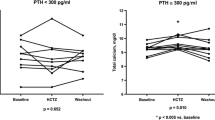Abstract
Background
While calcium carbonate is known to interfere with the gastrointestinal absorption of levothyroxine, we hypothesized that other phosphate binders would also bind to levothyroxine and decrease bioavailability of levothyroxine in dialysis patients.
Methods
The records of 1,566 patients on hemodialysis who were being treated by the Hypertension, Nephrology, Dialysis, and Transplantation Center (the regional renal referral center for Eastern Alabama, USA) were evaluated. The type of phosphate binder and amount were then correlated (two-tailed Pearson Correlation) to TSH levels, serum phosphorus and the amount of levothyroxine taken. Friedman Test and Wilcoxon Signed Ranks Test were performed to analyze the significance of difference in thyroxine dosing and TSH levels between the different phosphate binders.
Results
Sixty-seven patients were identified who were taking levothyroxine while taking three different kinds of phosphate binders; namely, calcium carbonate, calcium acetate, and sevelamer HCl. We found that the TSH levels of patients on calcium carbonate (P = 0.002) and sevelamer HCl (P = 0.033) were significantly higher than patients on calcium acetate with the difference increasing with time on each binder. Sevelamer was also found to be associated with significantly higher dosing requirement of thyroid replacement than those on either calcium carbonate or calcium acetate (Z = −3.17, P = 0.001).
Conclusion
Sevelamer (but not calcium acetate) in addition to calcium carbonate appears to interfere with the bioavailability of levothyroxine.

Similar content being viewed by others
References
Sperber AD, Liel Y (1992) Evidence for interference with the intestinal absorption of levothyroxine sodium by aluminum hydroxide. Arch Intern Med 152(1):183–184
Singh N, Singh PN, Hershman JM (2000) Effect of calcium carbonate on the absorption of levothyroxine. JAMA 283(21):2822–2825
Fleuren HW, Kho Y, Schuurmans MM, Vollaard EJ (2005) Drug interaction between sevelamer and furosemide. Nephrol Dial Transplant 20(10):2288–2289
Kays MB, Overholser BR, Mueller BA, Moe SM, Sowinski KM (2003) Effects of sevelamer hydrochloride and calcium acetate on the oral bioavailability of ciprofloxacin. Am J Kidney Dis 42(6):1253–1259
Lebkowska U, Malyszko J, Mysliwiec M (2003) Thyroid function and morphology in kidney transplant recipients, hemodialyzed, and peritoneally dialyzed patients. Transplant Proc 35(8):2945–2948
Qunibi WY, Hootkins RE, McDowell LL, Meyer MS, Simon M, Garza RO, Pelham RW, Cleveland MV, Muenz LR, He DY, Nolan CR (2004) Treatment of hyperphosphatemia in hemodialysis patients: the Calcium Acetate Renagel Evaluation (CARE Study). Kidney Int 65(5):1914–1926
Glahn RP, Rassier M, Goldman MI, Lee OA, Cha J (2000) A comparison of iron availability from commercial iron preparations using an in vitro digestion/Caco-2 cell culture model. J Nutr Biochem 11(2):62–68
Hwang SJ, Lai YH, Chen HC, Tsai JH (1992) Comparisons of the effects of calcium carbonate and calcium acetate on zinc tolerance test in hemodialysis patients. Am J Kidney Dis 19(1):57–60
Borrego J, Perez del Barrio P, Serrano P, Garcia Cortes MJ, Sanchez Perales MC, Borrego FJ, Liebana A, Gil Cunquero JM, Perez Banasco V (2000) A comparison of phosphorus-chelating effect of calcium carbonate versus calcium acetate before dialysis. Nefrologia 20(4):348–354
Sheikh MS, Maguire JA, Emmett M, Santa Ana CA, Nicar MJ, Schiller LR, Fordtran JS (1989) Reduction of dietary phosphorus absorption by phosphorus binders. A theoretical, in vitro, and in vivo study. J Clin Invest 83(1):66–73
Pieper AK, Haffner D, Hoppe B, Dittrich K, Offner G, Bonzel KE, John U, Frund S, Klaus G, Stubinger A, Duker G, Querfeld U (2006) A randomized crossover trial comparing sevelamer with calcium acetate in children with CKD. Am J Kidney Dis 47(4):625–635
Van Vlem B, Schoonjans R, Vanholder R, De Vos M, Vandamme W, Van Laecke S, Lameire N (2000) Delayed gastric emptying in dyspeptic chronic hemodialysis patients. Am J Kidney Dis 36(5):962–968
Hays MT (1988) Thyroid hormone, the gut. Endocr Res 14(2–3):203–224
Haynes RC (1991) Thyroid and antithyroid drugs, Chapter 57. In: Gilman AG et al (eds) Goodman and Gilman’s the pharmacological basis of therapeutics, 8th edn. Pergamon Press, New York, 1371p
Author information
Authors and Affiliations
Corresponding author
Rights and permissions
About this article
Cite this article
Diskin, C.J., Stokes, T.J., Dansby, L.M. et al. Effect of phosphate binders upon TSH and l-thyroxine dose in patients on thyroid replacement. Int Urol Nephrol 39, 599–602 (2007). https://doi.org/10.1007/s11255-006-9166-6
Received:
Accepted:
Published:
Issue Date:
DOI: https://doi.org/10.1007/s11255-006-9166-6




